Cenozoic Fault Growth Mechanisms in the Outer Apulian Platform
Abstract
1. Introduction
2. Geology of the Study Area
2.1. Stratigraphy
2.2. Structural Setting
3. Methodology
- Late Pliocene (Conglomerates) 1781 m/s;
- Middle Pliocene (Sands) 2763 m/s;
- Middle Pliocene (Clay) 3112 m/s;
- Middle Pliocene (Calcarenites) 2949 m/s;
- Early Pliocene 2599 m/s;
- Evaporitic Marl (Messinian) 2621 m/s.
4. Results
4.1. Fault Scarp Geometry
4.2. Thickness Profiles of Both Eocene and Pliocene Units
4.3. Cumulative Fault Throw Profiles
4.4. Incremental Fault Throw Profiles
- The Paleocene–Eocene throw distribution shows a maximum value of ca. 0.8 km at the northwestern tip of Fault A and local minima of ca. −0.4 km at the southern tip of Fault D. The negative throw value is related to the uplifted hanging wall block relative to the footwall block. Two separate bell-shaped profiles are documented along Fault A.
- The Miocene–Pliocene throw profile shows two separate bell-shaped profiles along the A to D fault segments. The first bell-shaped profile is characterized by a maximum value of ca. 1.2 km located at the intersection between Fault B and Fault C faults. The other maximum value of ca. 0.6 km is located at the southeastern end of Fault D.
- The Pleistocene throw distribution is very irregular, showing an asymmetric shape and numerous sudden variations. The computed values range from a few tens of meters (Fault A and Fault B) to ca. 500 m (Fault C and Fault D). Along the latter fault segments, the greatest values are located at their southeastern termination. Differently, the throw distribution profile is nearly flat along Fault A and almost null along Fault B.
5. Discussion
6. Conclusions
Author Contributions
Funding
Acknowledgments
Conflicts of Interest
References
- Channel, J.; D’Argenio, B.; Horvath, F. Adria, the African promontory in Mesozoic Mediterranean paleogeography. Earth Sci. Rev. 1979, 15, 213–292. [Google Scholar] [CrossRef]
- Dercourt, J.; Zonenshain, L.P.; Ricou, L.E.; Le Pichon, X.; Knipper, A.L.; Grandjaquet, C.; Sbortshikov, I.M.; Geussant, J.; Lepvrier, C.; Pechersku, D.H.; et al. Geological evolution of the Tethys belt from the Atlantic to the Pamirs since the Lias. Tectonophysics 1986, 123, 241–315. [Google Scholar] [CrossRef]
- De Alteriis, G. Different foreland basins in Italy: Examples from the central and southern Adriatic Sea. Tectonophysics 1995, 252, 349–373. [Google Scholar] [CrossRef]
- Dilek, Y. Collision tectonic of the Mediterranean region: Causes and consequences. GSA Spec. Paper 2006, 409, 1–13. [Google Scholar]
- Van Hinsbergen, D.J.J.; Torsvik, T.H.; Schmid, S.M.; Maţenco, L.C.; Maffione, M.; Vissers, R.L.; Gürer, D.; Spakman, W. Orogenic architecture of the Mediterranean region and kinematic reconstruction of its tectonic evolution since the Triassic. Gondwana Res. 2020, 81, 79–229. [Google Scholar] [CrossRef]
- Bertotti, G.; Picotti, V.; Chilovi, C.; Fantoni, R.; Merlini, S.; Mosconi, A. Neogene to Quaternary sedimentary basins in the south Adriatic (Central Mediterranean): Foredeeps and lithospheric buckling. Tectonics 2001, 20, 771–787. [Google Scholar] [CrossRef]
- Cicala, M.; Festa, V.; Sabato, L.; Tropeano, M.; Doglioni, C. Interference between Apennines and Hellenides foreland basins around the Apulian swell (Italy and Greece). Mar. Pet. Geol. 2021, 133, 105300. [Google Scholar] [CrossRef]
- Stampfli, G.M.; Borel, G.D. A plate tectonic model for the Paleozoic and Mesozoic constrained by dynamic plate boundaries and restored synthetic oceanic isochronos. Earth Planet Sci. Lett. 2002, 196, 17–33. [Google Scholar] [CrossRef]
- Schettino, A.; Turco, E. Tectonic history of the western Tethys since the late Triassic. Geol. Soc. Am. Bull. 2011, 123, 89–105. [Google Scholar] [CrossRef]
- Turco, E.; Macchiavelli, C.; Mazzoli, S.; Schettino, A.; Pierantoni, P. Kinematic evolution of Alpine Corsica in the framework of the Mediterranean mountain belts. Tectonophysics 2012, 579, 193–206. [Google Scholar] [CrossRef]
- Salvini, F.; Billi, A.; Wise, D.U. Strike-slip fault-propagation cleavage in carbonate rocks: The Mattinata Fault Zone, Southern Apennines, Italy. J. Struct. Geol. 1999, 21, 1731–1749. [Google Scholar] [CrossRef]
- Brankman, C.; Aydin, A. Uplift and contractional deformation along a segmented strike-slip fault system: The Gargano Promontory, southern Italy. J. Struct. Geol. 2004, 26, 807–824. [Google Scholar] [CrossRef]
- Argnani, A.; Rovere, M.; Bonazzi, C. Tectonics of the Mattinata fault, offshore south Gargano (southern Adriatic Sea, Italy): Implications for active deformation and seismotectonics in the foreland of the Southern Apennines. Geol. Soc. Am. Bull. 2009, 121, 1421–1440. [Google Scholar] [CrossRef]
- Santantonio, M.; Scrocca, D.; Lipparini, L. The ombrina-Rospo Plateau (apulian platform): Evolution of a carbonate platform and its margins during the jurassic and cretaceous. Mar. Petrol. Geol. 2013, 42, 4–29. [Google Scholar] [CrossRef]
- Vitale, S.; Amore, O.F.; Ciarcia, S.; Fedele, L.; Grifa, C.; Prinzi, E.P.; Tavani, S.; Tramparulo, F.D.A. Structural, stratigraphic, and petrological clues for a Cretaceous–Paleogene abortive rift in the southern Adria domain (southern Apennines, Italy). Geol. J. 2017, 53, 660–681. [Google Scholar] [CrossRef]
- Korneva, I.; Tondi, E.; Agosta, F.; Rustichelli, A.; Spina, V.; Bitonte, R.; Di Cuia, R. Structural properties of fractured and faulted Cretaceous platform carbonates, Murge Plateau (southern Italy). Mar. Pet. Geol. 2014, 57, 312–326. [Google Scholar] [CrossRef]
- Laurita, S.; Agosta, F.; Cavalcante, F.; Rustichelli, A.; Giorgioni, M. Shearing of syn-sedimentary carbonate breccia along strike-slip faults, Altamura Fm., Southern Italy. Ital. J. Geosci. 2016, 135, 41–54. [Google Scholar] [CrossRef]
- Panza, E.; Agosta, F.; Rustichelli, A.; Vinciguerra, S.; Dobbs, M.; Ougier-Simonin, A.; Prosser, G. Micro to mesoscales fracture porosity in tight limestones, insights from an integrated field and laboratory investigation. Mar. Pet. Geol. 2019, 103, 581–595. [Google Scholar] [CrossRef]
- Panza, E.; Agosta, F.; Rustichelli, A.; Zambrano, M.; Tondi, E.; Prosser, G.; Giorgioni, M.; Janiseck, J.M. Fracture stratigraphy and fluid flow properties of shallow-water, tight carbonates: The case study of the Murge Plateau (southern Italy). Mar. Pet. Geol. 2016, 73, 350–370. [Google Scholar] [CrossRef]
- Agosta, F.; Manniello, C.; Cavalcante, F.; Belviso, C.; Prosser, G. Late Cretaceous transtensional faulting of the Apulian Platform, Italy. Mar. Pet. Geol. 2021, 127, 104889. [Google Scholar] [CrossRef]
- Pieri, P.; Festa, V.; Moretti, M.; Tropeano, M. Quaternary tectonic activity of the Murge area (Apulian foreland—Southern Italy). Ann. Geofis. 1997, 40, 5. [Google Scholar] [CrossRef]
- Mariotti, G.; Doglioni, C. The dip of the foreland monocline in the Alps and Apennines. Earth Planet. Sci. Lett. 2000, 181, 191–202. [Google Scholar] [CrossRef]
- Petrullo, A.V.; Agosta, F.; Prosser, G.; Rizzo, E. Cenozoic tectonic evolution of the northern Apulian carbonate platform (southern Italy). Ital. J. Geosci. 2017, 136, 296–311. [Google Scholar] [CrossRef]
- Patacca, E.; Scandone, P. Geology of southern Apennines. Results of the CROP Project. Sub-project CROP-04. Boll. Soc. Geol. Ital. 2007, 7, 75–119. [Google Scholar]
- Vezzani, L.; Festa, A.; Ghisetti, F. Geology and Tectonic Evolution of the Central-Southern Apennines, Italy. GSA Spec. Pap. 2010, 469, 58. [Google Scholar]
- Walsh, J.J.; Watterson, J. Geometric and kinematic coherence and scale effects in normal fault systems. In The Geometry of Normal Faults; Roberts, A.M., Yielding, G., Freeman, B., Eds.; Geological Society, London, Special Publication: London, UK, 1991; Volume 6, pp. 193–203. [Google Scholar]
- Peacock, D.C.P.; Sanderson, D.J. Displacement, segment linkage and relay ramps in normal fault zones. J. Struct. Geol. 1991, 13, 721–733. [Google Scholar] [CrossRef]
- Cartwright, J.A.; Trudgill, B.D.; Mansfield, C.S. Fault growth by segment linkage: An explanation for scatter in maximum displacement and trace length data from the Canyonlands Grabens of SE Utah. J. Struct. Geol. 1995, 17, 1319–1326. [Google Scholar] [CrossRef]
- Dawers, N.H.; Anders, M.H. Displacement-lenght scaling and fault linkage. J. Struct. Geol. 1995, 17, 607–614. [Google Scholar] [CrossRef]
- Mansfield, C.S.; Cartwright, J.A. High resolution fault displacement mapping from three-dimensional seismic data: Evidence for dip linkage during fault growth. J. Struct. Geol. 1996, 18, 249–263. [Google Scholar] [CrossRef]
- Crider, J.G.; Pollard, D.D. Fault linkage: Three-dimensional mechanical interaction between echelon normal faults. J. Geophys. Res. Solid Earth 1998, 103, 24373–24391. [Google Scholar] [CrossRef]
- Cowie, P.A.; Roberts, G.P. Constraining slip rates and spacings for active normal faults. J. Struct. Geol. 2001, 23, 1901–1915. [Google Scholar] [CrossRef]
- Walsh, J.J.; Bailey, W.R.; Childs, C.; Nicol, A.; Bonson, C.G. Formation of segmented normal faults: A 3-D perspective. J. Struct. Geol. 2003, 25, 1251–1262. [Google Scholar] [CrossRef]
- Soliva, R.; Schultz, R.A. Distributed and localized faulting in extensional settings: Insight from the North Ethiopian Rift–Afar transition area. Tectonics 2008, 27, TC2003. [Google Scholar] [CrossRef]
- Kim, Y.S.; Sanderson, D.J. The relationship between displacement and length of faults: A review. Earth-Sci. Rev. 2005, 68, 317–334. [Google Scholar] [CrossRef]
- La Bruna, V.; Agosta, F.; Lamarche, J.; Viseur, S.; Prosser, G. Fault growth mechanisms and scaling properties in foreland basin system: The case study of Monte Alpi, Southern Apennines, Italy. J. Struct. Geol. 2018, 116, 94–113. [Google Scholar] [CrossRef]
- Scandone, P. Studi di geologia lucana: Carta dei terreni della serie calcareo-silico-marnosa e note illustrative. Boll. Soc. Nat. 1972, 81, 225–300. [Google Scholar]
- D’Argenio, B.; Pescatore, T.; Scandone, P. Schema geologico dell’Appennino Meridionale (Campania e Lucania). Accad. Naz. Dei Lincei 1973, 182, 49–72. [Google Scholar]
- Pescatore, T. Evoluzione tettonica del Bacino Irpino (Italia meridionale) durante il Miocene. Boll. Soc. Geol. Ital. 1978, 97, 783–805. [Google Scholar]
- Mostardini, F.; Merlini, S. Appennino centro meridionale. Sezioni geologiche e proposta di modello strutturale. Mem. Soc. Geol. Ital. 1986, 35, 177–202. [Google Scholar]
- Cello, G.; Lentini, F.; Tortorici, L. La Struttura del Settore Calabro-Lucano e suo Significato nel Quadro Dell’evoluzione Tettonica del Sistema a Thrust Sudappenninico; Studi Geologici Camerti, special issue; Università di Camerino: Camerino, Italy, 1990; pp. 27–34. [Google Scholar]
- Cello, G.; Tortorici, L.; Martini, N.; Paltrinieri, W. Structural styles in the frontal zones of the southern Apennines, Italy: An example from the Molise district. Tectonics 1989, 8, 753–768. [Google Scholar] [CrossRef]
- Patacca, E.; Scandone, P. Late trust propagation and sedimentary response in the thrust belt-foredeep system of the Southern Apennines (Pliocene-Pleistocene). In Anatomy of an Orogen: The Apennines and Adjacent Mediterranean Basins; Vai, G.B., Martini, I.P., Eds.; Kluwer Academic Publishers: New York, NY, USA, 2001; pp. 401–440. [Google Scholar]
- Patacca, E.; Sartori, R.; Scandone, P. Tyrrhenian basin and Apenninic arcs: Kinematic relations since Late Tortonian times. Mem. Soc. Geol. Ital. 1990, 45, 425–451. [Google Scholar]
- Bertotti, G.; Casolari, E.; Picotti, V. The Gargano Promontory: A Neogene contractional belt within the Adriatic plate. Terra Nova 1999, 11, 168–173. [Google Scholar] [CrossRef]
- Casolari, E.; Negri, A.; Picotti, V.; Bertotti, G. Neogene stratigraphy and sedimentology of the Gargano Promontory (southern Italy). Eclogae Geol. Helv. 2000, 93, 7–23. [Google Scholar]
- Billi, A.; Gambini, R.; Nicolai, C.; Storti, F. Neogene-Quaternary intraforeland transpression along a Mesozoic platform-basin margin: The Gargano fault system, Adria, Italy. Geosphere 2007, 3, 1–15. [Google Scholar] [CrossRef]
- Lentini, F. Carta Geologica del Bacino del Fiume Agri; Regione Basilicata-Dipartimento Assetto del Territorio: Firenze, Italy, 1991. [Google Scholar]
- Shiner, P.; Beccacini, A.; Mazzoli, S. Thin-skinned versus thick-skinned structural models for Apulian Carbonate Reservoirs: Constraints from the Val D’Agri Fields. Mar. Petrol. Geol. 2004, 21, 805–827. [Google Scholar] [CrossRef]
- Vitale, S.; Dati, F.; Mazzoli, S.; Ciarcia, S.; Guerriero, V.; Iannace, A. Modes and timing of fracture netwrok development in poly-deformed carbonate reservoir analogues, Mt. Chianello, southern Italy). J. Struct. Gel. 2012, 37, 223–235. [Google Scholar] [CrossRef]
- Ricchetti, G.; Ciaranfi, N.; Luperto Sinni, E.; Mongelli, F.; Pieri, P. Geodinamica ed evoluzione sedimentaria e tettonica dell’avampaese apulo. Mem. Soc. Geol. Ital. 1988, 41, 57–82. [Google Scholar]
- Ricchetti, G. Nuovi dati stratigrafici sul Cretaceo delle Murge emersi da indagini nel sottosuolo. Boll. Soc. Geol. Ital. 1975, 94, 1083–1108. [Google Scholar]
- Spalluto, L. Facies evolution and sequence chronostratigraphy of a “mid”-Cretaceous shallow-water carbonate succession of the Apulia Carbonate Platform from the northern Murge area (Apulia, southern Italy). Facies 2012, 58, 17–36. [Google Scholar] [CrossRef]
- Bosellini, A.; Morsilli, M.; Neri, C. Long-term event stratigraphy of the Apulia platform margin (Upper Jurassic to Eocene, Gargano, Southern Italy). J. Sediment. Res. 1999, 69, 1241–1252. [Google Scholar] [CrossRef]
- Migliorini, C. Elementi basaltici in una breccia calcarea luteziana nel sottosuolo di Genzano di Lucania. Boll. Soc. Geol. Ital. 1944, 62, 50–51. [Google Scholar]
- Sella, M.; Turci, C.; Riva, A. Sintesi geopetrolifera della Fossa Bradanica (Avanfossa della catena Appenninica). Mem. Soc. Geol. Ital. 1988, 41, 87–107. [Google Scholar]
- Vlahović, I.; Tišljar, J.; Velić, I.; Matićec, D. Evolution of the Adriatic Carbonate Platform: Palaeogeography, main events and depositional dynamics. Palaeogeogr. Palaeoclimatol. Palaeoecol. 2005, 220, 333–360. [Google Scholar] [CrossRef]
- Crescenti, U. Stratigrafia della serie calcarea dal Lias al Miocene nella regione marchigiano—Abruzzese. Mem. Soc. Geol. Ital. 1969, 8, 343–420. [Google Scholar]
- Roveri, M.; Bassetti, M.A.; Ricci Lucchi, F. The Mediterranean Messinian salinity crisis: An Apennine foredeep perspective. Sediment. Geol. 2001, 140, 201–214. [Google Scholar] [CrossRef]
- Sgrosso, I. Nuovi dati biostratigrafici sul Miocene del M. Alpi (Lucania) e conseguenti ipotesi paleogeografiche. Mem. Soc. Geol. Ital. 1988, 41, 343–351. [Google Scholar]
- Bertello, F.; Fantoni, R.; Franciosi, R.; Gatti, V.; Ghielmi, M.; Pugliese, A. From thrust-and-fold belt to foreland: Hydrocarbon occurrences in Italy. Geol. Soc. Lond. Pet. Geol. Conf. Ser. 2010, 7, 113–126. [Google Scholar] [CrossRef]
- Casero, P. Structural setting of petroleum exploration plays in Italy. Spec. Vol. Ital. Geol. Soc. IGC 2004, 32, 189–199. [Google Scholar]
- La Bruna, V.; Agosta, F.; Prosser, G. New insights on the structural setting of the Monte Alpi area, Basilicata, Italy. Ital. J. Geosci. 2017, 136, 220–237. [Google Scholar] [CrossRef]
- Azzaroli, A. Calcarenite di Gravina. Studi illustrativi della Carta Geologica d’Italia—Formazioni Geologiche. Serv. Geol. D’italia 1968, 1, 183–185. [Google Scholar]
- Ciaranfi, N.; Marino, M.; Sabato, L.; D’Alessandro, A.; De Rosa, R. Studio geologico stratigrafico di una successione infra e mesopleistocenica nella parte sudoccidentale della Fossa Bradanica (Montalbano Ionico, Basilicata). Boll. Soc. Geol. Ital. 1996, 115, 379–391. [Google Scholar]
- Carissimo, L.; D’Agostino, O.; Loddo, C.; Pieri, M. Le ricerche petrolifere dell’AGIP mineraria e nuove informazioni geologiche nell’Italia centro meridionale dall’Abruzzo al Golfo di Taranto. In Proceedings of the VI Petroleum World Congress, Frankfurt, Germany, 19–26 June 1962. [Google Scholar]
- Cello, G.; Mazzoli, S. Apennine tectonics in southern Italy: A review. J. Geodyn. 1998, 27, 191–211. [Google Scholar] [CrossRef]
- Butler, R.W.H.; Mazzoli, S.; Corrado, S.; De Donatis, M.; Scrocca, D.; Di Bucci, D.; Gambini, R.; Naso, G.; Nicolai, C.; Shiner, P.; et al. Applying Thick-Skinned Tectonic Models to the Apennine Thrust Belt of Italy—Limitations and Implications. In Thrust Tectonics and Hydrocarbon Systems; K.R. McClay, Ed.; The American Association of Petroleum Geologists: Tulsa, OK, USA, 2004; Volume 82, pp. 647–667. [Google Scholar]
- Borgomano, J.R.F. The Upper Cretaceous carbonates of the Gargano-Murge region, southern Italy: A model of platform-to-basin transition. AAPG Bull. 2000, 84, 1561–1588. [Google Scholar]
- Tropeano, M.; Marino, M.; Pieri, P. Evidenze di tettonica distensiva plio-pleistocenica al margine orientale della Fossa bradanica—l’Horst di Zagarella. Il Quat. 1994, 7, 597–606. [Google Scholar]
- Iannone, A.; Pieri, P. Caratteri neotettonici delle Murge. Geol. Appl. Idrogeol. 1982, 17, 147–159. [Google Scholar]
- Tropeano, M.; Pieri, P.; Moretti, M.; Festa, V.; Calgnile, G.; Del Gaudio, V.; Pieri, P. Tettonica quaternaria ed elementi di sismotettonica nell’area delle Murge (Avampaese Apulo). Il Quat. 1997, 10, 543–548. [Google Scholar]
- Festa, V. Cretaceous structural features of the Murge area (Apulian Foreland, southern Italy). Eclogae Geol. Helv. 2003, 96, 11–22. [Google Scholar]
- Ciaranfi, N.; Guida, M.; Iaccarino, G.; Pescatore, T.; Pieri, P.; Rapisardi, L.; Turco, E. Elementi sismotettonici dell’Appennino meridionale. Boll. Soc. Geol. Ital. 1983, 102, 201–222. [Google Scholar]
- Funiciello, R.; Montone, P.; Parotto, M.; Salvini, F.; Tozzi, M. Geodynamical interpretation of an intra-orogenic foreland: The Apulia case history (Italy). Boll. Soc. Geol. Ital. 1991, 110, 419–425. [Google Scholar]
- Gambini, R.; Tozzi, M. Tertiary geodynamic evolution of the Southern Adria microplate. Terra Nova 1996, 8, 593–602. [Google Scholar] [CrossRef]
- Nicolai, C.; Gambini, R. Structural architecture of the Adria platform-and-basin system. Boll. Soc. Geol. Ital. 2007, 7, 21–37. [Google Scholar]
- Watterson, J. Fault dimensions, displacements and growth. Pure Appl. Geophys. 1986, 124, 365–373. [Google Scholar] [CrossRef]
- Walsh, J.J.; Watterson, J. Analysis of the relationship between displacements and dimensions of faults. J. Struct. Geol. 1988, 10, 239–247. [Google Scholar] [CrossRef]
- Cowie, P.A.; Scholz, C.H. Physical explanation for the displacement-lenght relationship for faults using a post-yield fracture mechanics model. J. Struct. Geol. 1992, 14, 1133–1148. [Google Scholar] [CrossRef]
- Schlische, R.W.; Young, S.S.; Ackermann, R.V.; Gupta, A. Geometry and scaling relations of a population of very small rift-related normal faults. Geology 1996, 24, 683–686. [Google Scholar] [CrossRef]
- Muraoka, H.; Kamata, H. Displacement distribution along minor fault traces. J. Struct. Geol. 1983, 5, 483–495. [Google Scholar] [CrossRef]
- Barnett, J.A.; Mortiner, J.; Rippon, J.H.; Walsh, J.J.; Waternson, J. Displacement geometry in the volume containing a single normal fault. AAPG Bull. 1987, 71, 925–937. [Google Scholar]
- Walsh, J.J.; Watterson, J. Distributions of cumulative displacement and seismic slip on a single normal fault surface. J. Struct. Geol. 1987, 9, 1039–1046. [Google Scholar] [CrossRef]
- Huggins, P.; Watterson, J.; Walsh, J.J.; Childs, C. Relay zone geometry and displacement transfer between normal faults recorded in coal-mine plans. J. Struct. Geol. 1995, 17, 1741–1755. [Google Scholar] [CrossRef]
- Nicol, A.; Watterson, J.; Walsh, J.J.; Childs, C. The shapes, major axis orientations and displacement patterns of fault surfaces. J. Struct. Geol. 1996, 18, 235–248. [Google Scholar] [CrossRef]
- Manighetti, I.; Campillo, M.; Sammis, C.; Mai, P.M.; King, G. Evidence for self-similar, triangular slip distributions on earthquakes: Implications for earthquake and fault mechanics. J. Geophys. Res. Solid Earth 2005, 110, B05302. [Google Scholar] [CrossRef]
- Schlagenhauf, A.; Manighetti, I.; Malavieille, J.; Dominguez, S. Incremental growth of normal faults: Insights from a laser-equipped analog experiment. Earth Planet. Sci. Lett. 2008, 273, 299–311. [Google Scholar] [CrossRef]
- Roche, V.; Homberg, C.; Rocher, M. Fault displacement profiles in multilayer systems: From fault restriction to fault propagation. Terra Nova 2012, 24, 499–504. [Google Scholar] [CrossRef]
- Dewey, J.F.; Helman, M.L.; Turco, E.; Hutton, D.H.W.; Knott, S.D. Kinematics of the Western Mediterranean; Coward, M.P., Dietrich, D., Park, R.G., Eds.; Geological Society, London, Special Publications: London, UK, 1989; Volume 45, pp. 265–283. [Google Scholar]
- Mindszenty, A.; D’Argenio, B.; Aiello, G. Lithospheric bulges recorded by regional unconformities. The case of Mesozoic-Tertiary Apulia. Tectonophysics 1995, 252, 137–161. [Google Scholar] [CrossRef]
- Giba, M.; Walsh, J.J.; Nicol, A. Segmentation and growth of an obliquely reactivated normal fault. J. Struct. Geol. 2012, 39, 253–267. [Google Scholar] [CrossRef]
- Camanni, G.; Roche, V.; Childs, C.; Manzocchi, T.; Walsh, J.J.; Conneally, J.; Saqab, M.M.; Delogkos, E. The three-dimensional geometry of relay zones within segmented normal faults. J. Struct. Geol. 2019, 129, 103895. [Google Scholar] [CrossRef]
- Mandelbrot, B.; Pignoni, R. The Fractal Geometry of Nature; WH Freeman: New York, NY, USA, 1983; p. 173. [Google Scholar]
- Torabi, A.; Berg, S.S. Scaling of fault attributes: A review. Mar. Pet. Geol. 2011, 28, 1444–1460. [Google Scholar] [CrossRef]
- Marrett, R.; Ortega, O.J.; Kelsey, C.M. Extent of power-law scaling for natural fractures in rock. Geology 1999, 27, 799–802. [Google Scholar] [CrossRef]
- Pickering, G.; Peacock, D.C.; Sanderson, D.J.; Bull, J.M. Modeling tip zones to predict the throw and length characteristics of faults. AAPG Bull. 1997, 81, 82–99. [Google Scholar]
- Gupta, A.; Scholz, C.H. A model of normal fault interaction based on observations and theory. J. Struct. Geol. 2000, 22, 865–879. [Google Scholar] [CrossRef]
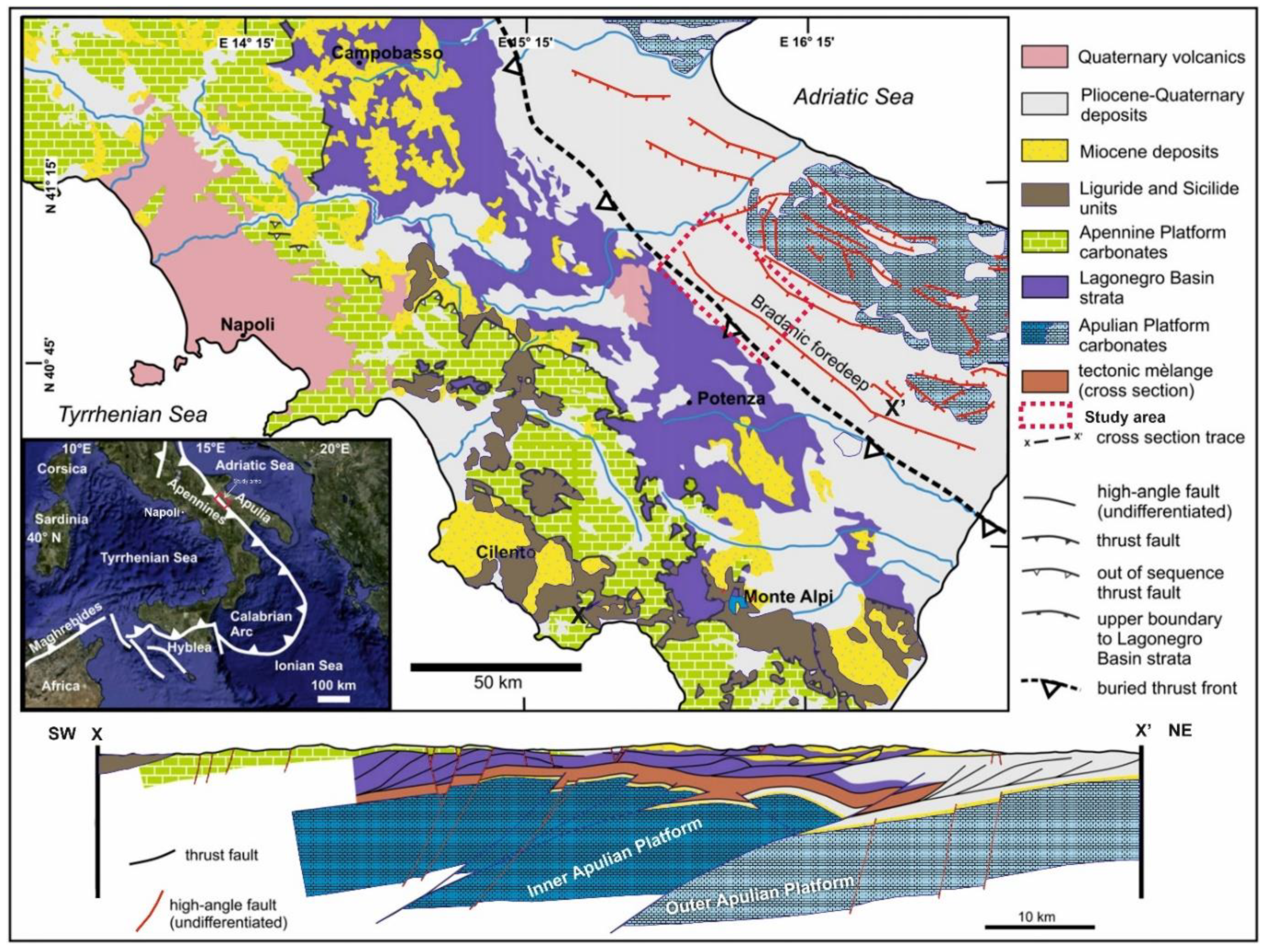
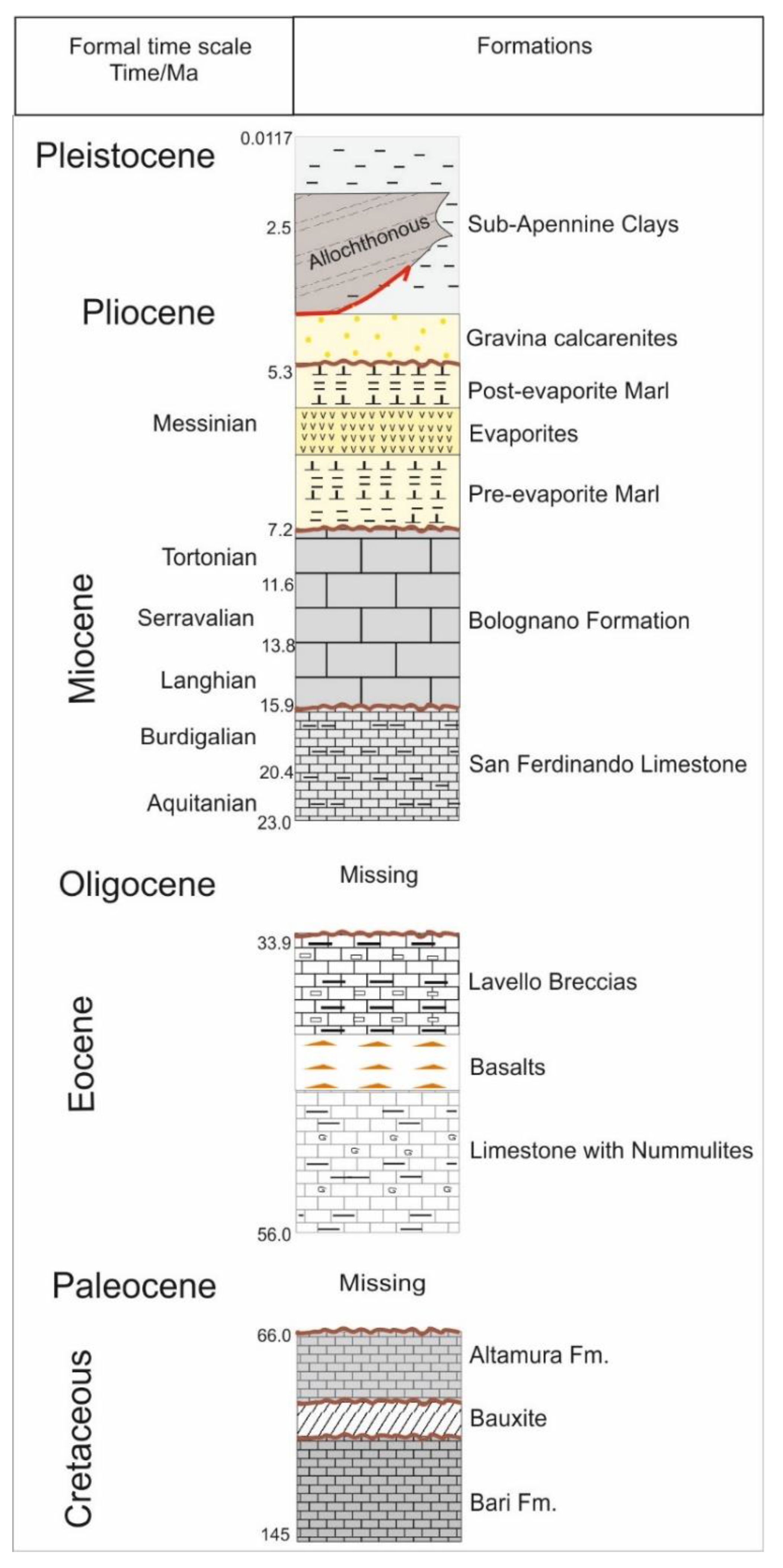

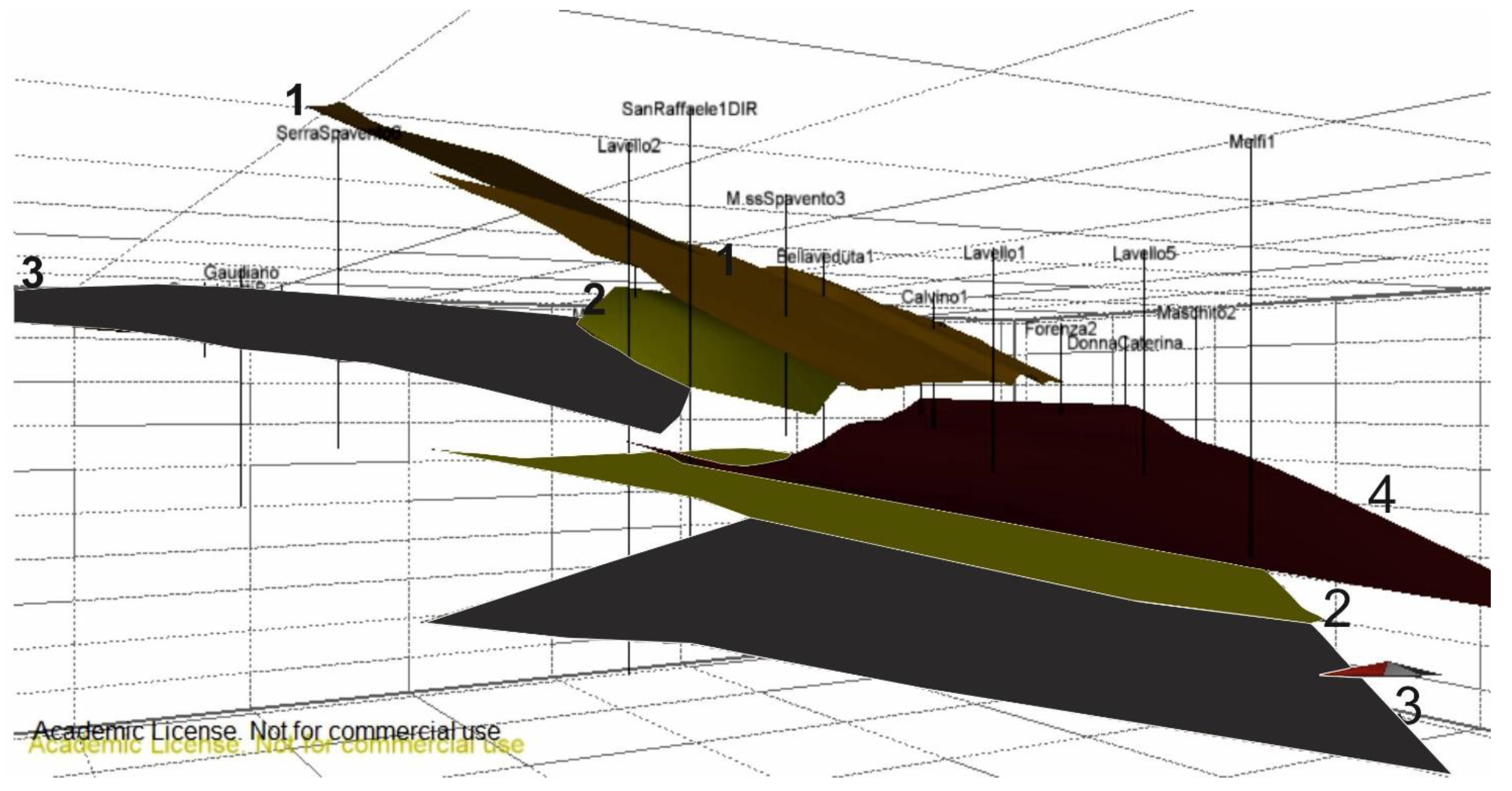

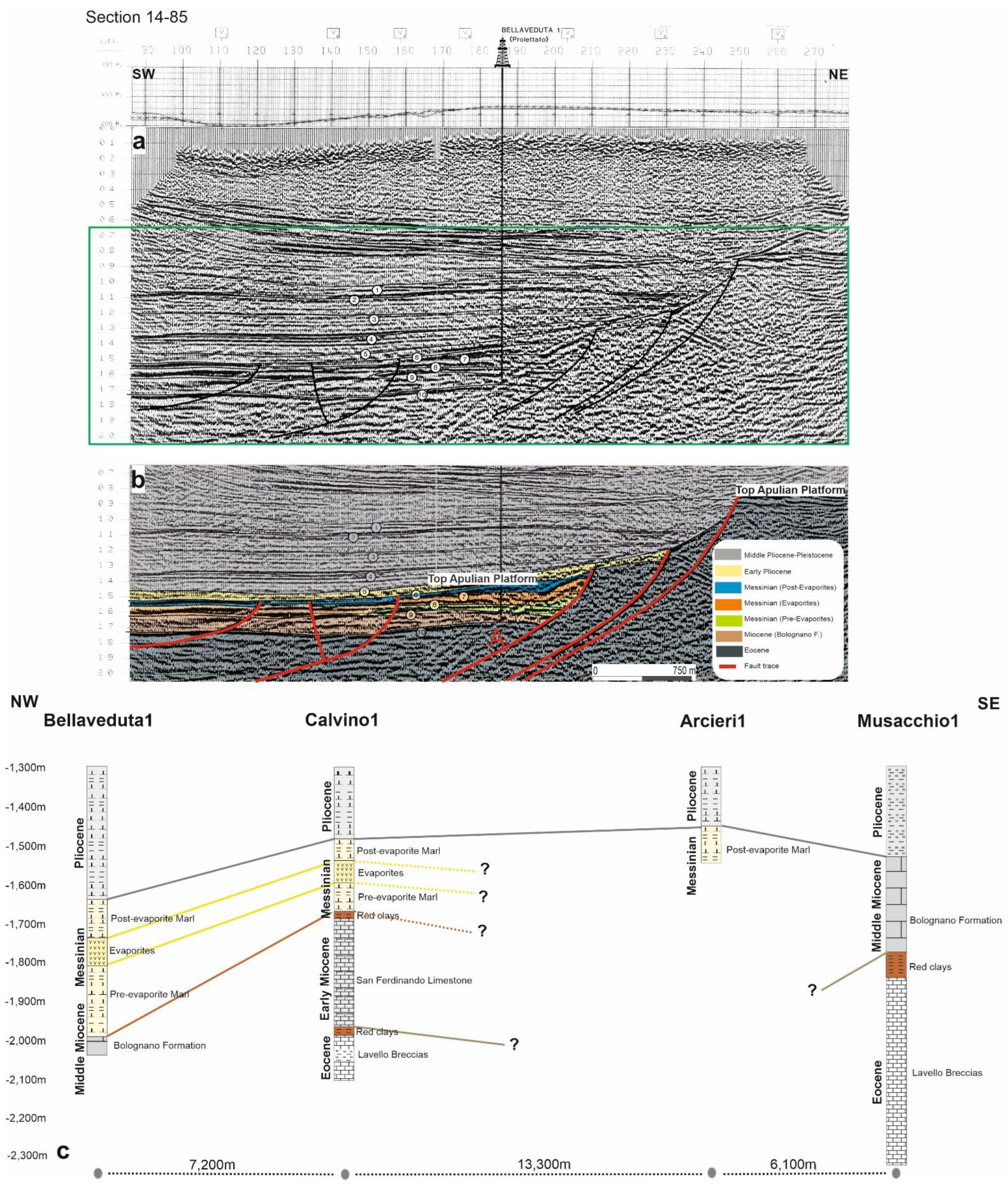

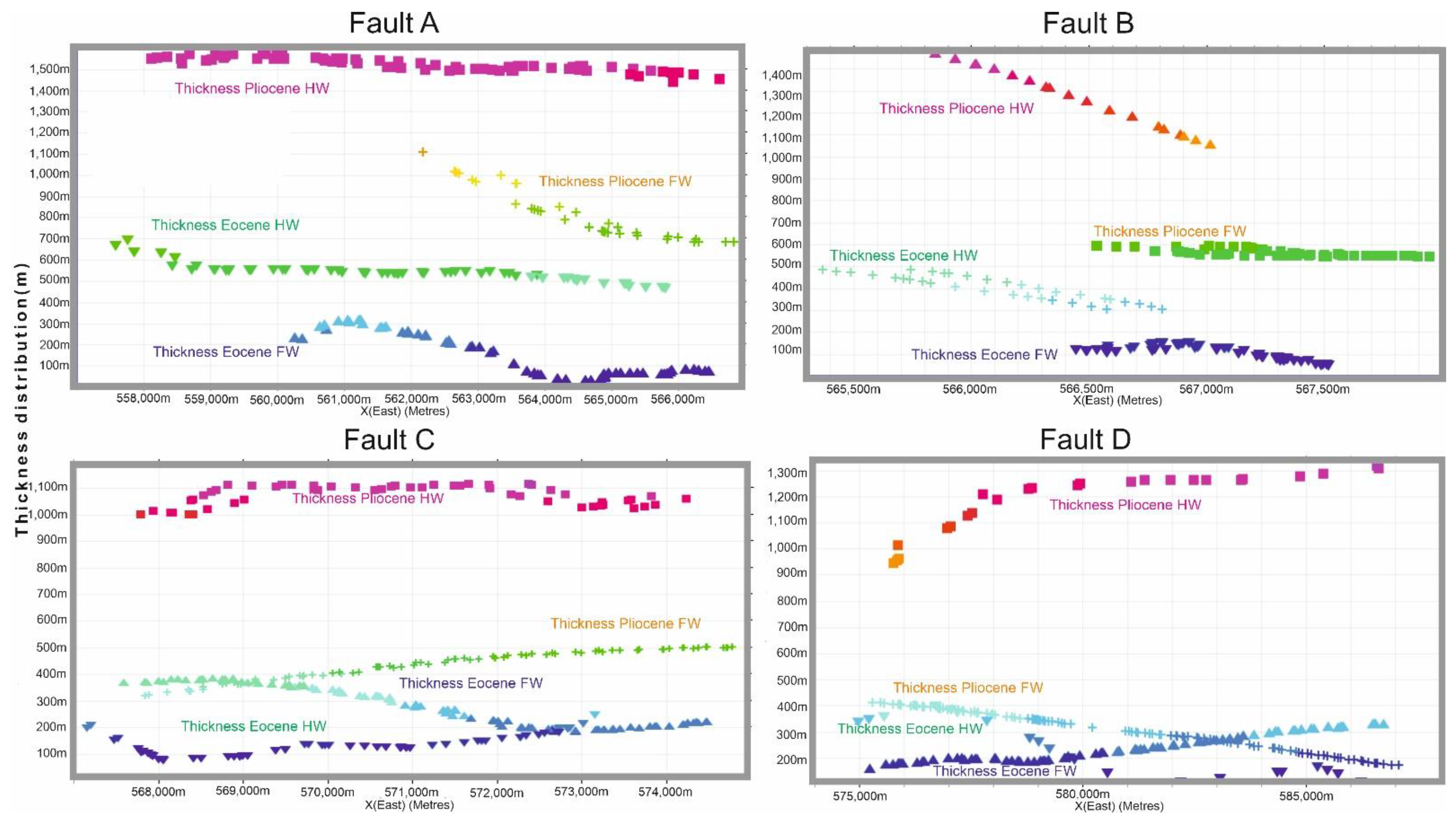



| Paleocene–Eocene | ||
| NAME | LENGTH (km) | THROW (km) |
| A1 | 9.0 | 0.83 |
| A2 + B | 10.0 | 0.49 |
| D1 | 6.5 | 0.18 |
| Miocene–Pliocene | ||
| NAME | LENGTH (km) | THROW (km) |
| A1 + A2 + B + C + D1 | 43.0 | 1.20 |
| D2 | 20.0 | 0.59 |
| Pleistocene | ||
| NAME | LENGTH (km) | THROW (km) |
| A1 + A2 + B | 16.0 | 0.22 |
| C + D1 + D2 | 23.0 | 0.53 |
Disclaimer/Publisher’s Note: The statements, opinions and data contained in all publications are solely those of the individual author(s) and contributor(s) and not of MDPI and/or the editor(s). MDPI and/or the editor(s) disclaim responsibility for any injury to people or property resulting from any ideas, methods, instructions or products referred to in the content. |
© 2023 by the authors. Licensee MDPI, Basel, Switzerland. This article is an open access article distributed under the terms and conditions of the Creative Commons Attribution (CC BY) license (https://creativecommons.org/licenses/by/4.0/).
Share and Cite
Agosta, F.; Petrullo, A.V.; La Bruna, V.; Prosser, G. Cenozoic Fault Growth Mechanisms in the Outer Apulian Platform. Geosciences 2023, 13, 121. https://doi.org/10.3390/geosciences13040121
Agosta F, Petrullo AV, La Bruna V, Prosser G. Cenozoic Fault Growth Mechanisms in the Outer Apulian Platform. Geosciences. 2023; 13(4):121. https://doi.org/10.3390/geosciences13040121
Chicago/Turabian StyleAgosta, Fabrizio, Angela Vita Petrullo, Vincenzo La Bruna, and Giacomo Prosser. 2023. "Cenozoic Fault Growth Mechanisms in the Outer Apulian Platform" Geosciences 13, no. 4: 121. https://doi.org/10.3390/geosciences13040121
APA StyleAgosta, F., Petrullo, A. V., La Bruna, V., & Prosser, G. (2023). Cenozoic Fault Growth Mechanisms in the Outer Apulian Platform. Geosciences, 13(4), 121. https://doi.org/10.3390/geosciences13040121







